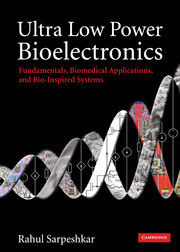Book contents
- Frontmatter
- Contents
- Acknowledgements
- Section I Foundations
- Section II Low-power analog and biomedical circuits
- Section III Low-power RF and energy-harvesting circuits for biomedical systems
- Section IV Biomedical electronic systems
- Section V Principles for ultra-low-power analog and digital design
- Section VI Bio-inspired systems
- Section VII Energy sources
- 25 Batteries and electrochemistry
- 26 Energy harvesting and the future of energy
- Bibliography
- Index
- Epilogue
- References
25 - Batteries and electrochemistry
from Section VII - Energy sources
Published online by Cambridge University Press: 02 December 2010
- Frontmatter
- Contents
- Acknowledgements
- Section I Foundations
- Section II Low-power analog and biomedical circuits
- Section III Low-power RF and energy-harvesting circuits for biomedical systems
- Section IV Biomedical electronic systems
- Section V Principles for ultra-low-power analog and digital design
- Section VI Bio-inspired systems
- Section VII Energy sources
- 25 Batteries and electrochemistry
- 26 Energy harvesting and the future of energy
- Bibliography
- Index
- Epilogue
- References
Summary
I have been so electrically occupied of late that I feel as if hungry for a little chemistry: but then the conviction crosses my mind that these things hang together under one law.
Michael FaradayUltra-low-power electronic systems often utilize batteries. The battery is frequently the heaviest and most critical portion of a portable system. The battery's size, weight, energy density, power density, form factor, cycling properties and lifetime can dictate constraints under which a portable electronic system must operate. Such constraints include the overall power dissipation of the system, the number of recharges that are possible in the system, the expected lifetime of the system, the overall size of the system, and the overall cost of the system. In this chapter, we shall provide a brief introduction to batteries with an emphasis on intuition and knowledge that is useful for providing insight into battery operation and ultra-low-power system design.
First, we shall begin with an exposition of the basic principles by which chemical energy is converted to electrical energy in a battery. Then, we shall discuss an equivalent circuit for a battery that intuitively describes several effects that are observed in practical batteries. We shall discuss the basics of lithium-ion and zinc-air batteries, two of the most common and most efficient batteries in existence in ultra-low-power electronic systems, particularly biomedical ones. We shall also briefly discuss the benefits of fuel cells and ultra capacitors, devices that are capable of being used in conjunction with or instead of batteries, and that are likely to be important in the future.
- Type
- Chapter
- Information
- Ultra Low Power BioelectronicsFundamentals, Biomedical Applications, and Bio-Inspired Systems, pp. 789 - 821Publisher: Cambridge University PressPrint publication year: 2010



